With the new Eagle Powertrain motor and drivetrain system, SRAM promise to simplify trail riding – with automatic shifting, integrated components, and just two support modes. We’ve already put the ebike motor system through its paces in four different eMTBs around the globe. Read on to find out whether SRAM succeed in their mission and actually make trail riding easier, and why they’re faced with a dilemma!

SRAM’s Apollo mission is not about to land on the moon, but they’re about to shake up the industry once again, just shortly after the bombshell that was the direct-mount Transmission drivetrain. The American brand present their first complete eMTB motor system. And when SRAM say complete, they don’t just mean a motor, but also their own, in-house hardware, software, and an integrated drivetrain. That said, they didn’t develop their own motor, but based it on the Brose Drive S Mag instead, which is precisely what premium bike Specialized did for their Specialized 2.2 motor. This allowed SRAM to focus on the development of the software, battery, display, remotes, and the integration of the SRAM Transmission drivetrain. With a torque output of 90 Nm and a maximum power output of 680 watts, the specs are similar to those of the motor it’s based on. For the introduction of the new complete package, however, it was necessary to wait until after the launch of the wireless SRAM Transmission drivetrain, which we’ve already reviewed for you here. It was needed to ensure the necessary shifting performance, thereby enabling the new Powertrain motor system to perform automatic shifting – even under load. Conversely, the inclusion of the Transmission groupset also means that there will hardly be any bikes with a SRAM motor that don’t rely on the Transmission drivetrain, which means the price will be a bitter pill to swallow. SRAM work closely with the various bike brands to find the best possible solution regarding the integration of the system. They also take care of everything surrounding after sales service, and don’t shirk responsibility, as is often the case when bike brands rely on third-party systems.
When it comes to automatic shifting, however, SRAM aren’t alone. With the launch of the 2022 Shimano DEORE XT Di2 derailleur, Shimano also introduced an automatic mode for the Shimano EP801 motor.
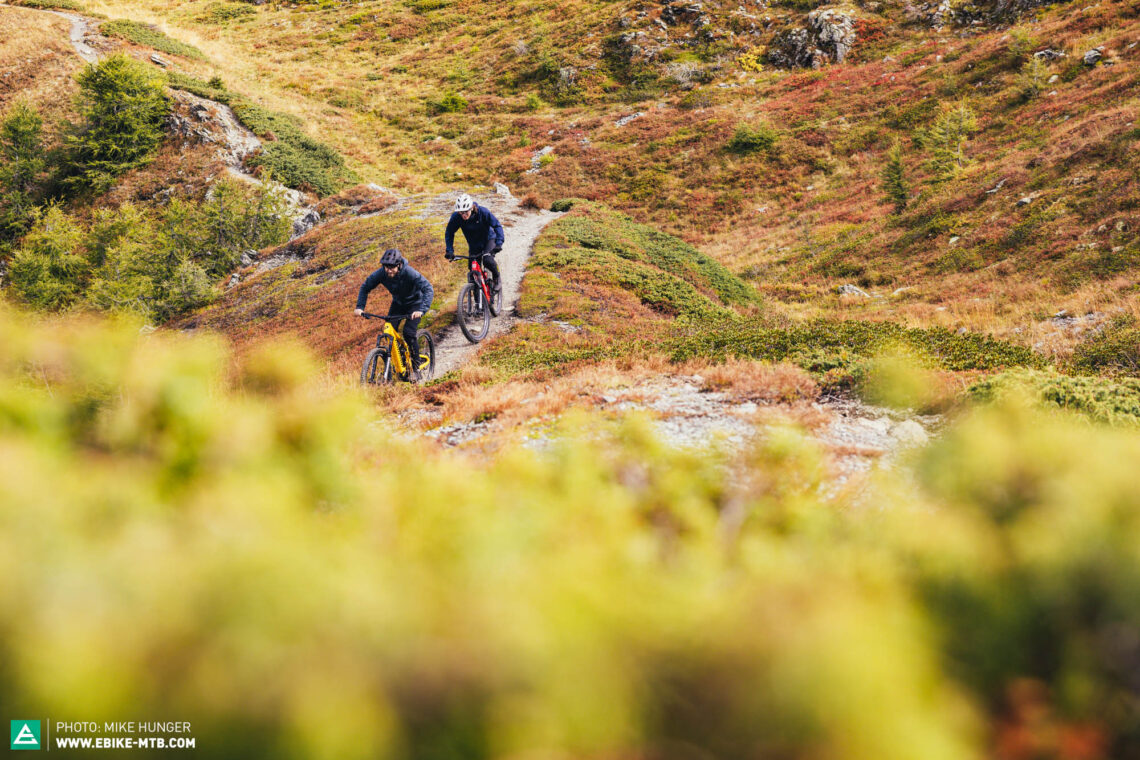
The new SRAM Eagle Powertrain in detail
The SRAM Eagle Powertrain system is based on the proven Brose Drive S Mag motor, which is best known from the Specialized Turbo Levo. You can tell by the proportions that the ebike motor is somewhat outdated: the area around the bottom bracket in particular is large and bulky. Inside, it boasts the same technology as the Brose Drive S Mag. The power is transmitted by a system consisting of belt drive and dual sprag clutch. That way you don’t have any resistance when pedalling without the motor’s assistance, and you can still pedal home relatively easily in the event of an empty battery. However, the first generation Brose Drive S Mag often had problems with the belt drive, but SRAM claim that it’s been slightly revised since, so that should no longer be an issue. The specially developed software from SRAM is also intended to mitigate load peaks to some degree and thereby further reduce strain on the belt. The key performance specs of the Eagle Powertrain are almost identical to the stock Brose motor. The Powertrain also churns out 90 Nm of torque and weighs 2.98 kg. At its peak, the motor delivers 680 watts of power, surpassing the Bosch Performance Line CX top dog with its 600 watt maximum. Caution: these isolated factory specs provide limited information about the real-world performance of an ebike motor. It’s still the performance on the trail that matters most, and this depends on countless other variables.
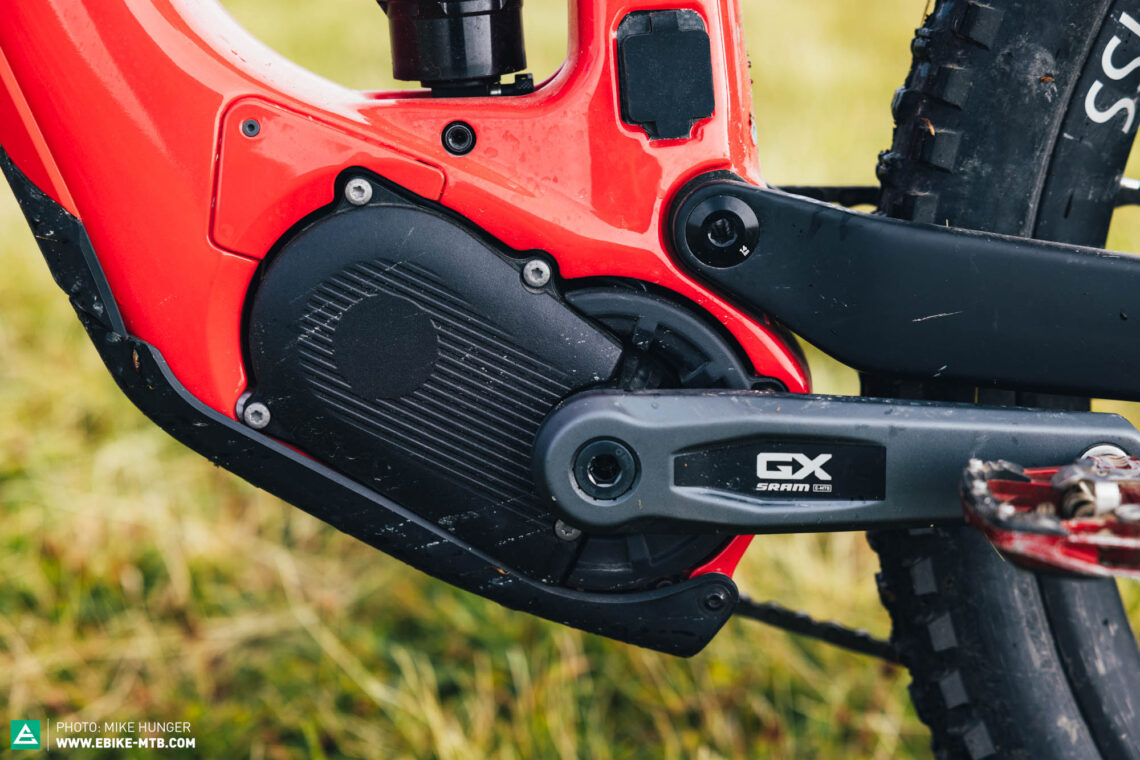
It’s not just the software that comes from SRAM, but also the batteries, and the controls, all of which have been developed for the Eagle Powertrain from the ground up. There are two different battery options to power the motor, differing in their capacity, proportions, and the way they’re attached to the bike. The smaller 630 Wh battery simply flips out of the underside of the down tube. However, there’s a screw under the battery cover that must be loosened before you can take out the battery. Furthermore, there are metal clips that hold the battery in place, preventing it from just dropping out of the frame once you’ve loosened the screw. It will come out with a slight tug. The larger 720 Wh version can either slide out of the bottom end of the down tube or be permanently integrated. At 4.1 kg, it weighs just under a kilo more than the smaller compact-size version. It’s up to the bike brands and their concepts to decide which battery they choose, whether permanently integrated or removable.
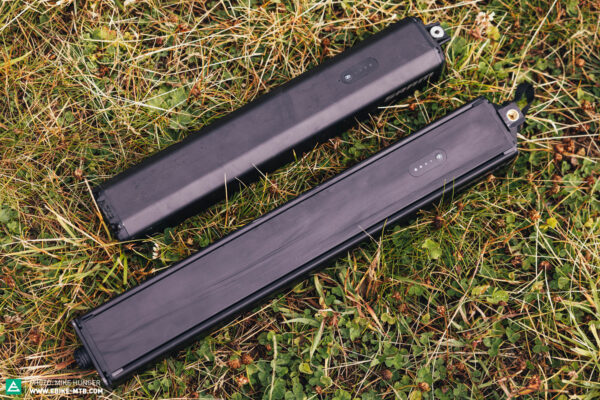
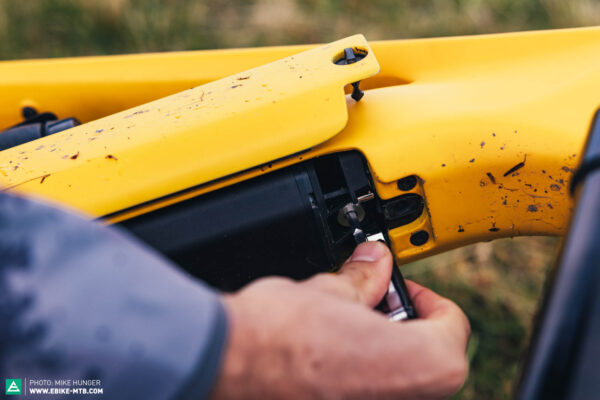

For the long-distance riders amongst you who want to take on extended tours without having to recharge between stops, SRAM are planning to offer a 250 Wh range extender. However, it doesn’t simply slot into any bottle cage like many other models from other manufacturers, but attaches to a purpose built bracket. This should guarantee a secure hold even on demanding trails, and can either be integrated directly into the frame or attached to the bottle cage bosses. SRAM have also thought of designing a bottle cage that clips onto the bracket of the range extender, so you don’t have to remove the bracket every time you want to carry a water bottle instead of the range extender. However, the motor can only tap into range extender when you’ve got it set to the weaker Range support mode. In Rally mode, the motor draws its energy exclusively from the main battery, because the range extender can’t provide the required power. So, those who always like riding in Rally mode like Colin McRae can only use the range extender to make their way back home in the lower support mode once they’ve drained the main battery.
The displays and remotes of the SRAM Eagle Powertrain
The AXS Bridge display serves as the control centre of the SRAM Eagle Powertrain. Like most other manufacturers, SRAM integrate the display into the top tube. Unfortunately, it doesn’t sit flush with the frame. This is due to the antenna that the control centre uses to communicate with the system’s remaining components. That said, the display unit makes a robust impression, consisting of a small colour screen and two buttons. The button below the screen is used to toggle between support modes while the top button is used to power the motor on and off. The system can also be put into service mode by briefly pressing the latter. Apart from the motor, it’s an always-on system, including the drivetrain. This is particularly useful when you have to make a short pit stop on the trail or free your cassette from some of the debris that you’ve collected on the trail. Caution: you should always make sure that you’ve switched off the motor before fiddling with the drivetrain! The display provides the most important information such as the battery level percentage, and the selected support and shifting mode. The fact that the SRAM Eagle Powertrain only has two support modes, Range and Rally, further underscores the brand’s focus on minimalism. While Rally mode unleashes the system’s full power for demanding terrain, Range mode is tuned more for moderate terrain and conserving energy for longer distances. You can adjust the maximum power and dynamics of the support modes to a certain degree via the app. There’s a small info button in the setup menu that helps beginners quickly find their way around.
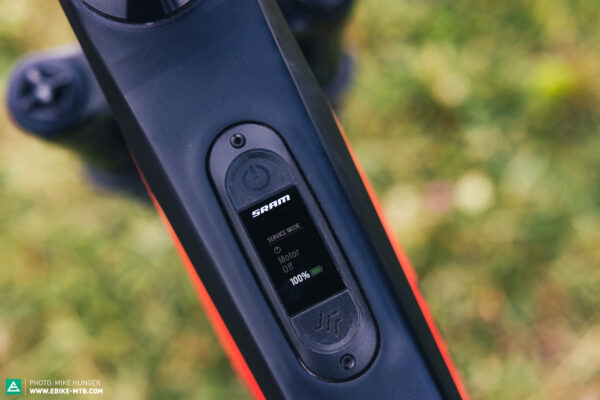
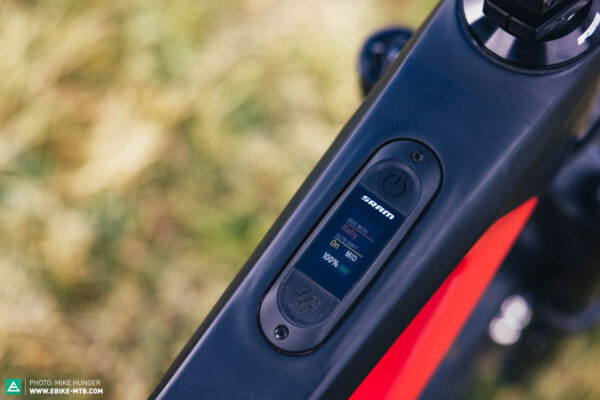
The Eagle Powertrain system doesn’t come with a dedicated remote. Whether it’s changing the support and shifting modes, shifting gears, or actuating the dropper post, you do it all via the two AXS Pods on the handlebar. The rubberised buttons feel great, and the defined click provides immediate feedback, so there’s no need to look at the display for confirmation. The lack of an additional remote and the position of the Pods under the handlebar makes for a super clean looking cockpit. However, it also means that some of the buttons must be assigned with two functions. For example, you can use the top button of the right Pod to shift to an easier gear by pressing it briefly, or long-press it to toggle the Auto-Shift function. The AXS app allows you to assign functions according to your own preferences. In addition to assigning Pod functions, the SRAM app provides access to all other settings, making it your one-stop-shop. As with the Shimano E-Tube app, it doesn’t simply allow you to adjust the motor and drivetrain, but also provides an overview of and lets you manage all the components paired with the AXS system. Updates are also downloaded via the AXS app and installed via the AXS Bridge display. This eliminates the hassle of updating each component separately. The current software is yet to offer helpful functions like navigation and electronic anti-theft protection via the app. While the Brose ebike app has a navigation function, it doesn’t communicate with the AXS Bridge display, so you’ll have to take your smartphone out of your pocket every time you want to check the route. When it comes to tuning the motor, the SRAM AXS app takes the lead over the Brose ebike app. The settings of the latter aren’t very well thought out, and the support modes can be adjusted without limitations. That way, you can turn the Eco mode into Turbo. You also only get one parameter per support mode, with an adjustment range of 0–100. This is where SRAM and Specialized set themselves apart, going into much more detail and allowing you to set several parameters in each mode.

Automatic shifting with the SRAM Transmission
Many of you might be wondering why you would need automatic shifting. The Auto-Shift function of the SRAM Transmission groupset is designed to make riding easier, so the rider can concentrate fully on the trail without having to worry about shifting gears. As with any digitally controlled system, you will always get software updates, and so it is with SRAM Transmission Auto-Shift. As such, its functionality is constantly evolving and improving. The average rider is said to perform around 200 gear shifts per hour. Initially, the SRAM Transmission Auto-Shift performed around 2,000 gear shifts per hour, shifting around 10 times more often to ensure an optimal cadence. Thanks to software updates, SRAM Auto-Shift now performs around 700 gear shifts per hour, depending on the terrain.
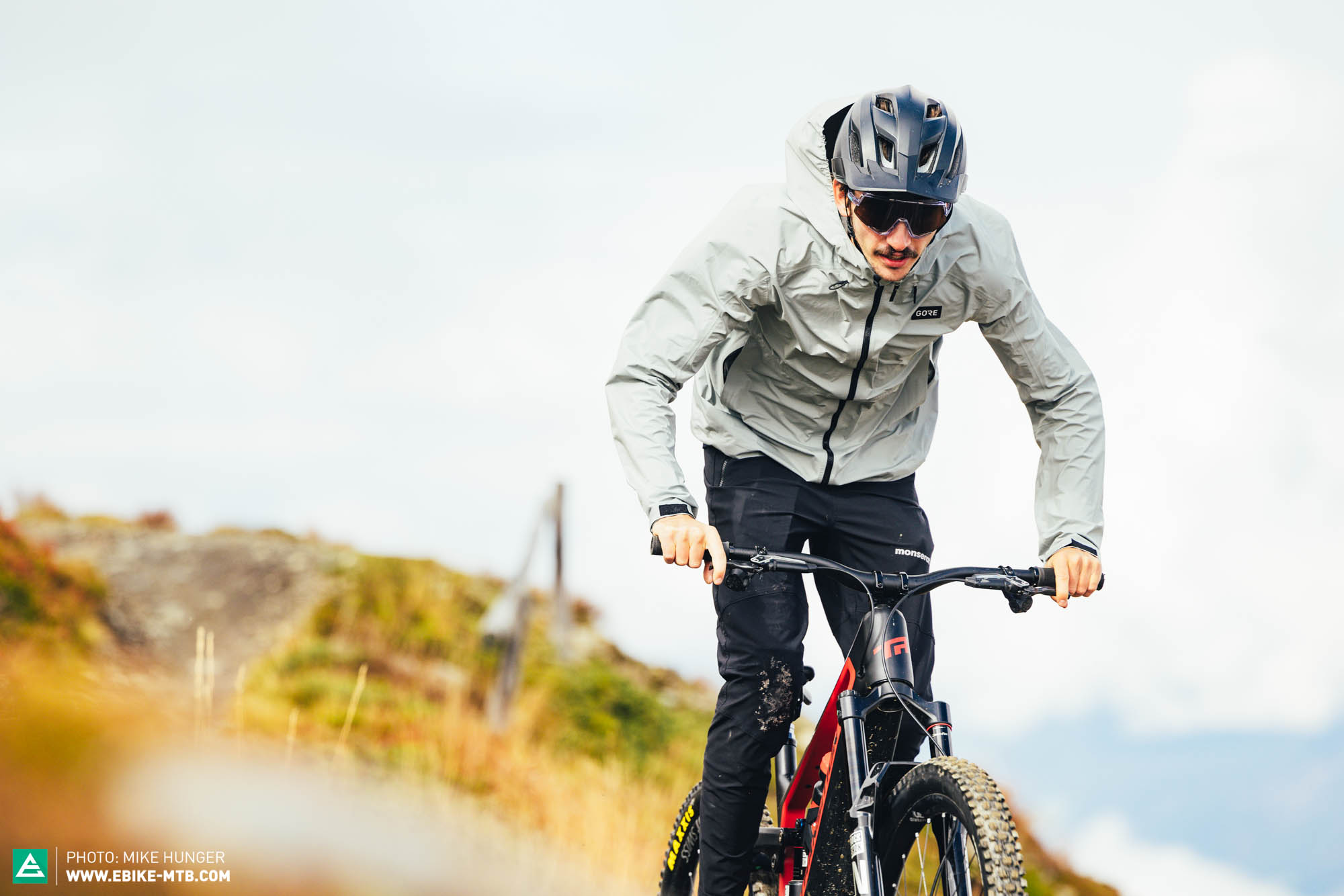
Looking at it from the outside, you’ll hardly find any difference to the conventional SRAM Transmission groupset. But when you take a closer look, you’ll notice that the derailleur isn’t powered by a separate battery as it’s plugged directly into the main battery instead. However, this also means that you can only shift gears when the system is switched on. Shifting gears and the controlling system happens as usual via the AXS Pods. There are a total of 6 magnets instead of just one on the rear brake rotor, ensuring more accurate speed detection for the shifting algorithm, and allowing the system to automatically shift to the ideal gear in Auto-Shift mode. The motor spins the chainring while the derailleur shifts – you don’t need to pedal. However, it can’t shift while stationary since the motor can only turn the chainring if the rear wheel is also turning, thus allowing the cassette to turn. In the default setting, the algorithm assumes 85 RPM to be the ideal cadence and selects the gear accordingly. You can use the Pods to move the desired cadence up or down in three steps while riding. However, you can always shift manually, even when you’ve got Auto-Shift activated. Doing so overrides the algorithm and deactivates it for about 5 seconds. That way you always have the option to manually shift gears yourself, which you might want to do if you see an obstacle coming up for which you’ll need an easier gear. The Coast-Shift function – i.e. shifting without having to pedal – is always available, even if the Auto-Shift function is deactivated.

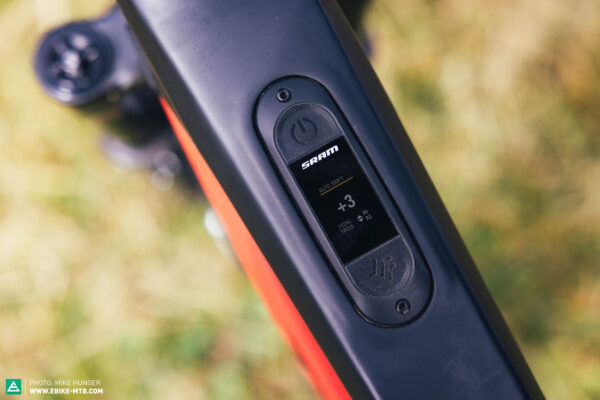
The SRAM Eagle Powertrain on the trail
Naturally, the first question to arise as you set off is: Range or Rally? When opting for the latter and leaving it in the default settings, the SRAM Eagle Powertrain provides ample thrust and is just as powerful as the Bosch Performance Line CX. If you decide to take the most direct route to the summit, the long sustained response helps you get up and over obstacles. Aggressive riders benefit from the direct response, especially on technical climbs, though the support isn’t too harsh and delivers a natural ride feel, nonetheless. This is underlined by the fact that you’ll barely notice the motor cutting out above the 25 km/h threshold. The motor doesn’t throw riders with irregular pedal strokes out of the saddle either, because it corrects for cadence fluctuations, making it easy to use for beginners. Since it’s based on the same motor, the SRAM Eagle Powertrain feels as easy and intuitive to ride as Specialized Turbo eMTBs with the 2.2 motor. In Range mode, the Eagle Powertrain is significantly more hesitant to unleash its power and kicks in later. Therefore, this mode is more suitable for leisurely rides, rather than letting yourself get shuttled to the summit at 25 km/h or tackling uphill challenges – but that’s what Rally mode is for.

Combined with the Powertrain motor, the SRAM Transmission drivetrain is well-suited to relaxed cruising as you make your way to the trailhead thanks to the Auto-Shift function. It takes some getting used to, because it will occasionally shift gears in places where you wouldn’t necessarily do so yourself. In the MID setting, the cadence feels quite fast on flat terrain, and you’ll feel little resistance on the pedals. When riding uphill, the cadence that you start out with slows down gradually, and it feels a bit tedious. Depending on whether they were riding on flat terrain or uphill, our testers always adjusted the RPM up or down slightly via the remote in order to maintain a pleasant pedalling cadence. If you exceed the 25 km/h limit and the motor is longer assisting, the system continues shifting into higher gears. We would have liked the motor to recognise that the rider no longer has any assistance and adjust the gear selection accordingly. As it is, you’ll quickly find yourself in a gear that’s too heavy, especially on fast, flat trails. The SRAM Transmission Auto-Shift algorithm is incredibly sophisticated, but it can’t look at the trail or path ahead. If there’s a sudden steep climb at the bottom of a descent, the shifting algorithm doesn’t have enough time to shift to an easier gear. In situations like these, you’ll have to use the Override function to bypass the AutoShift function temporarily, or even deactivate it altogether to shift manually to select the appropriate gear before you hit the climb or obstacle. You must often work against the system, especially on technical climbs, and you’re better advised to deactivate Auto-Shift completely, otherwise you’ll constantly be fighting it and overriding it every time it kicks back in. If you’re just rolling along without pedalling, you never know which gear you’re in, as the system is constantly changing gears. While it might be in roughly the appropriate gear, the system can’t catch up if you brake suddenly before hitting a corner, and you’ll be in the wrong gear to pedal out of it. If you shift manually, on the other hand, you often know intuitively which gear you were in as you railed the previous turn. Auto Shift works better on leisurely tours with consistent pedalling cadences, where the system has more time to recognise the riding situation and adapt the gear choice.
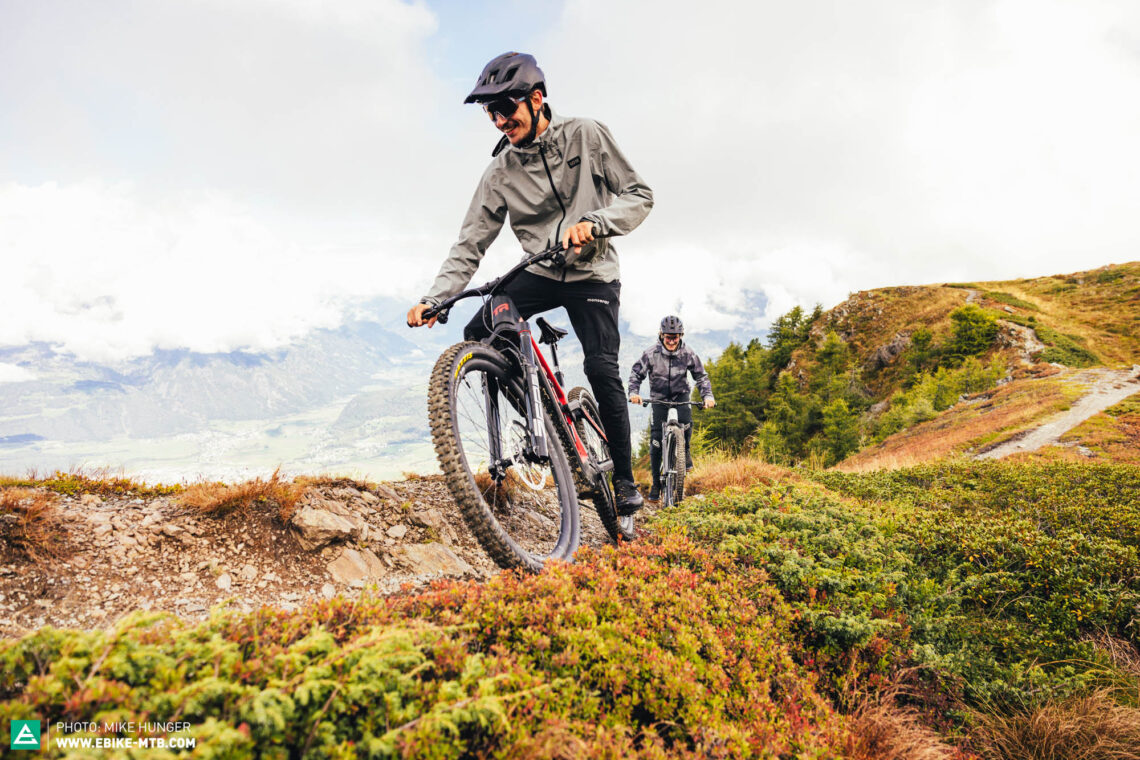
With Auto-Shift disabled, the Coast-Shift feature comes into play. This allows you to shift into the right gear in anticipation of corners or obstacles without having to pedal, and you can shift up quickly on a descent without wasting your energy to spin the cranks until the gears have caught up. When navigating rough, technical terrain, you can easily switch to an easier gear without running the risk of snagging your pedals on roots or rocks while keeping your cranks in a stable horizontal position. This makes it easier to focus on the obstacles in front of you.
The Auto-Shift function of the SRAM Eagle Powertrain and integrated Transmission groupset isn’t like the automatic transmission in a car, where you no longer have to worry about shifting gears while driving. Auto-Shift is capable of dealing with a large number of scenarios on relaxed tours, but as soon as you encounter technical terrain that requires you to think and shift ahead, like a descent quickly followed by a steep climb, you can’t get around manual shifting.

Finally, the SRAM AXS shifting components produce an electrical shifting noise every time they shift. Some love it, others hate it. Especially since the SRAM Transmission Auto-Shift function shifts significantly more often than you would manually.
SRAM Transmission Auto-Shift and Coast-Shift vs Shimano DEORE XT Di2 AUTO SHIFT and FREE SHIFT
Like SRAM with the Transmission and Eagle Powertrain, Shimano’s DEORE XT Di2 drivetrain offers automatic shifting and a so-called FREE SHIFT mode, which allows you to shift without pedalling. No matter whether it’s the SRAM or Shimano system shifting gears automatically in their respective automatic modes, both concepts are better suited to touring or shuttling to the next trailhead. Neither of the systems are smart enough to free you from having to think about shifting when things get technical. On the contrary, you’ll find yourself constantly fighting the shifting algorithms to stay in the right gear. The target cadence of the automatic shifting modes can be adjusted on both SRAM and Shimano systems via the Pods or the trigger. Both allow you to override the auto mode for a short period of time and shift gears yourself. On steep climbs, the SRAM Transmission groupset manages to shift gears a little more reliably and smoothly than the Shimano DEORE XT Di2.

Who is the SRAM Eagle Powertrain for?
The SRAM Eagle Powertrain system isn’t for the budget minded, as it’s currently reserved almost exclusively for high-end performance eMTBs due to the integration of the Transmission drivetrain. Currently, the price range of known bikes with SRAM Eagle Powertrain ranges between € 7.999 and € 13.399. Although the system doesn’t make other AXS components like the AXS dropper post mandatory, it makes sense, especially in terms of integration. It also seems questionable to combine such an expensive system with budget suspension or brakes, for example. If the bike is then combined with a mechanical instead of wireless seatpost, for example, the left AXS pod is exchanged for a cable and a conventional dropper remote. However, this also means that you lose the walk mode and that the support modes have to be selected directly from the display on the top tube. The motor itself is aimed at active riders who prioritise trail performance. Above all, they will benefit from the Coast-Shift mode, which allows pedal-free shifting on the trail and actually does make riding technical terrain easier. On the other hand, the Auto-Shift mode doesn’t always hit the mark – especially on technical climbs and dynamic situations – often making things more difficult for the rider. This mode makes more sense for touring, though there are currently no suitable touring bikes with the SRAM Eagle Powertrain system on the market, and this target group is usually unwilling to pay such a high price.
Our conclusion on the SRAM Eagle Powertrain
The SRAM Eagle Powertrain introduces some cool and exciting new tech. The motor doesn’t just offer a natural ride feel, but it’s also capable of automatic shifting. The SRAM Eagle Powertrain is good for shuttling, but it reaches its limits in demanding and technical terrain where you must look, think, and act ahead. Furthermore, the soon-to-be available eMTBs with the SRAM Eagle Powertrain and Transmission ecosystem will all be high-priced and exclusive, so it’s not accounting for riders on a budget.
Tops
- complete, integrated package consisting of the motor system and drivetrain
- very natural ride feel of the motor
- Auto-Shift is great for relaxed shuttling and touring
Flops
- bulky
- only makes sense as a complete system with AXS components
- Auto-Shift can’t deal with technical terrain
- hefty price point of available eMTBs
For more information, visit sram.com

Did you enjoy this article? If so, we would be stoked if you decide to support us with a monthly contribution. By becoming a supporter of E-MOUNTAINBIKE, you will help secure a sustainable future for high-quality cycling journalism. Click here to learn more.
Words: Mike Hunger Photos: Mike Hunger









